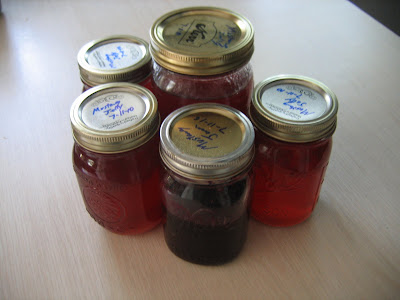 If there are two things I like, one is being told (and on more than one occasion) that I’m a bit of a Maverick, and the other one is sweet, sweet jelly. This may be why I liked the idea of harvesting the wild Texas Mustang Grapes from my dad’s vacant and overgrown lot. The Mustang grape vine lives there by itself with no help to speak of except for the poor tree which it climbs on. It lives from the sun and water which fall from the sky. There are no ferts, and certainly no human help.
If there are two things I like, one is being told (and on more than one occasion) that I’m a bit of a Maverick, and the other one is sweet, sweet jelly. This may be why I liked the idea of harvesting the wild Texas Mustang Grapes from my dad’s vacant and overgrown lot. The Mustang grape vine lives there by itself with no help to speak of except for the poor tree which it climbs on. It lives from the sun and water which fall from the sky. There are no ferts, and certainly no human help.If you haven’t heard of Mustang Grapes, there’s a good reason. People aren’t exactly beating down the door of the supermarket to get to these suckers. Honestly, I’ve never tasted one raw. I’ve only seen the expression on Carrie’s face when she tried one and I was afraid if she ate another her face would stick like that. Being the scientist at heart that I am, I did try one on my unsuspecting son and daughter to verify the results. Equally contorted sour faces confirmed we were dealing with some potent stuff. I’d heard it makes good jelly though…
The other problem with dealing with these freebies is their high acid content. While not enough melt iron, it is enough to make your hands go red in irritation from handling them. This especially makes the project a challenge because in everything you do, you come in contact with the juice. I’d heard it makes good jelly though…
We are lucky enough to have a juicer we got at a steal of a price. This baby will take the juice out of a carrot on low and the orange color out on high. It is strong. Grapes should be along the line of child’s play for this machine, right? Actually, it works too well! The process of extracting the juice gives you another product mixed in with the juice which I can only describe as brown acidic slime. I’m telling you, this job is not for the faint of heart. I’d heard it makes good jelly though…
Sparing the details, I tried several methods for separating the juice from the slime and the easiest way to get it is to let it sit for 24 hours in the fridge in a pitcher. The slime is lighter than the juice and will float to the top where you simply skim it off. Rereading that sentence, “skim it off the top” sounds positively understated - we’re talking about a pitcher filled with 10 inches of the juice/slime mix, easily 6 inches will be slime! What is left is a really beautiful juice with a color somewhere between crimson and coral. The second best way is to take the pulp from the juicer and put it in a strainer and let gravity pull the juice from the pulp. This produces almost as much juice as the separating method, though you have to work harder at straining the junk out.
There is another way to prepare the grapes if you don’t have a juicer. Place the grapes (washed and de-stemmed) in a large pot and cook on high on the stove. Stir occasionally, and the grape skins begin to crack open. They also turn an amazing cranberry color. After all have “popped,” turn off burner and mash (we used an avocado masher). Then place mashed grapes and juice in a strainer. We had to additionally use a spoon against the insides of the strainer to “encourage” the juice to actually strain through. Interestingly, compared to machine-juicing, this method ended up producing a much thicker jelly – almost more like a jam. So thick, in fact, that we didn’t even need to add pectin to this batch – just sugar. And instead of a coral color, it is deep purple.

The Jam
And now the taste test… Carrie looks ok this round… The kids are brave enough to try it again and are actually smiling… Here goes…. It actually produces a really good jelly! It has a very pleasant, slightly tart taste that you can’t get in a store bought jar. It’s wonderful. I really do believe all of that trouble is well worth the pleasure of taming these wild Texas grapes.








No comments:
Post a Comment